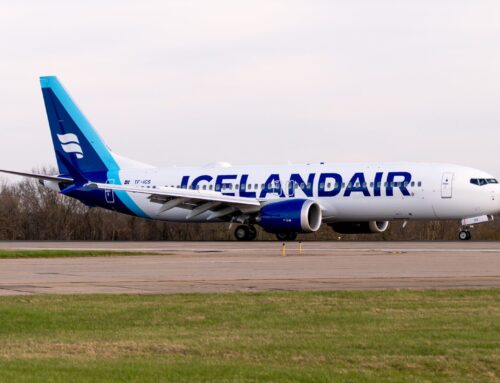Airlines Cut Schedules Amid Efforts to Limit Coronavirus Spread
Flights trimmed, planes grounded as industry grapples with rapidly changing situation
By Matt Neistein
Published March 17, 2020
Read Time: 5 mins
After a tumultuous week in which international travel was severely curtailed, professional sports shut down and schools closed around the country, the U.S. aviation industry finds itself looking at a radically altered business landscape.
Flights to and from China and the Pacific region were suspended weeks ago as government officials tried to limit the spread of COVID-19, a novel coronavirus that has infected more than 168,000 people worldwide and led to nearly 7,000 deaths since surfacing in December.
RELATED STORY: Grounded Aircraft Find a Place to Park at PIT
In January, the U.S. government blocked the entry of foreign nationals who had recently traveled to China, and last week, President Trump announced a 30-day ban on foreign travelers entering the country from Europe, as well.
These measures, along with the general public’s growing concern about being exposed to the virus, have had a dramatic impact on both airlines and airports, some of which are making unprecedented moves to adapt to severely decreased demand.
RELATED STORY: How are your airline’s ticket policies affected by coronavirus? Click here to find out
- Delta Air Lines is cutting capacity – the total number of seats on its flights – by 40 percent over the next few months, CEO Ed Bastian told employees last week. That is the biggest reduction in capacity in the company’s history, surpassing even 9/11.
Among the cuts, Delta will suspend nearly all of its service to continental Europe for at least 30 days. At Pittsburgh International Airport, Delta is only reducing 1 percent of its capacity as of March 15, trimming its flight schedule to Atlanta in April.
- American Airlines announced it will cut 75 percent of its international capacity through May 6 and ground most of its widebody fleet. Domestic capacity will be reduced by 20 percent in April and 30 percent in May.
At PIT, American will end its flights to Phoenix Sky Harbor on June 4, one of several Phoenix flights being cut or scaled back on its national schedule. American is also reducing frequencies to Chicago-O’Hare and Philadelphia. Also in June, American will reduce its daily flights from PIT to New York Kennedy to one from the previous four.
- United was the first major U.S. carrier to announce cuts, saying it would reduce international capacity by 20 percent and domestic capacity by 10 percent in April. On Sunday, the carrier said that would increase to a 50 percent cut in capacity for April and May, with the cuts likely extending into the summer.
At PIT, United is scaling back its capacity by 13 percent in April, reducing daily frequencies to Chicago O’Hare, Newark International, Washington Dulles and San Francisco International.
- Southwest Airlines, which carries more passengers at PIT than any other airline, has yet to announce any schedule cuts in connection with the coronavirus crisis, but has said it is “seriously considering” cutting flights on a short-term basis.
- Allegiant Air’s 15 nonstop destinations from PIT are second only to Southwest, and the ultra-low-cost carrier has cut only two flights to Punta Gorda, Florida, from its schedule, reducing the total number of departures to PGD to 14 in May. The carrier says the coronavirus has not impacted its overall schedule.
- Spirit Airlines will reduce its schedule by 5 percent in April, CEO Ted Christie said. At PIT, Spirit’s capacity will drop 6.8 percent, with two fewer weekly flights to Ft. Lauderdale and Orlando, and the soon to be twice-daily route to Los Angeles International will be cut back to once-daily on several days.
- JetBlue is contemplating a 5 percent cut to its schedule and will consider reducing capacity on a month-to-month basis, president Joanna Geraghty said. At PIT, the carrier will cut some flights to Boston Logan in April, dropping its capacity at Pittsburgh by 3 percent.
- Canada’s largest airline, Air Canada, has not announced any widespread changes to its U.S. schedule because of coronavirus, though the carrier has been making adjustments to their network rapidly, with more changes expected to this week. At PIT, the airline is cutting two of its weekly Montreal flights and cutting Toronto service from three times daily to twice daily in April.
While instituting new cleaning protocols and other measures to combat the spread of the virus, Pittsburgh International has been anticipating reduced service from its airline partners since the early days of the outbreak and has been planning accordingly.
“As global pandemics can create shockwaves throughout the aviation and travel industry, we have been tracking the response by airlines, cargo carriers, and passengers since very early this year,” said Bryan Dietz, ACAA Vice President of Air Service Development. “We know more schedule reductions will be coming as we are expecting demand levels lower than the post-Sept. 11, 2001, period.”
RELATED STORY: Airport Authority CEO says airports are adapting to rapidly changing industry
Most airlines have begun waiving cancellation or booking change fees for customers adjusting their travel plans, as well as expanded terms for credits and refunds. But several airlines are already announcing internal measures, as well.
United is freezing hiring, delaying merit raises and offering employees voluntary unpaid leave. Delta is parking 300 planes and cutting capital spending along with a hiring freeze and offers of unpaid leave, and CEO Bastian said he will stop taking a salary.
The big picture
The global impact of coronavirus on the airline industry is already being felt, but its full effect on bottom lines won’t be known for months. However, industry groups are painting a stark picture.
On Friday, Airports Council International—North America updated its estimate for member losses in 2020 to $5.7 billion, up from a $3.7 billion estimate just a day earlier, before new travel restrictions to Europe went into effect.

A few passengers go through the security checkpoint at Pittsburgh International Airport on March 16. (Photo by Beth Hollerich)
On March 5, the International Air Transport Association, an airline trade group, predicted global losses of $113 billion in a “worst-case scenario” for the industry in 2020 related to coronavirus impacts. A week later, it said that estimate didn’t account for “severe measures” world governments later enacted to combat the spread of the virus.
And as flight schedules are reduced and passenger loads drop, both aeronautical revenue (income derived from ticket sales and airline fees) and non-aeronautical revenue (income from concessions, parking, advertising, etc.) is beginning to dip for airports.
Globally, ACI World expects that airports will fall more than $4 billion short of their forecasted first-quarter income, although American airports will only account for about $100 million of that shortfall.
Helping out
As carriers ground large portions of their fleets, they encounter a new problem: lack of parking spaces.
Airlines typically do not own entire airports or swaths of land designed to hold significant numbers of aircraft. Most of their facilities are hangars designated for maintenance and similar purposes, not storage.
As a former hub turned origin-and-destination market, Pittsburgh International finds itself in the unique position of having lots of space that is rarely used, one of the factors driving a billion-dollar Terminal Modernization Program that will “right-size” the airport.
The Allegheny County Airport Authority, which operates PIT, has begun offering some of that space for aircraft that are being sidelined as a result of schedule cuts, and airlines are already responding.
This partnership is indicative of the symbiotic relationship between airlines and airports, and it offers hope that the aviation industry will rebound quickly with a joint effort.
“This is uncharted territory for all of us and it’s stunning in its impact to the entire aviation ecosystem, of which airports are critical,” said Pittsburgh International Airport CEO Christina Cassotis. “Working with our airline partners and public health agencies, we will do what’s best to keep our passengers safe and our airports open. That never changes.”






